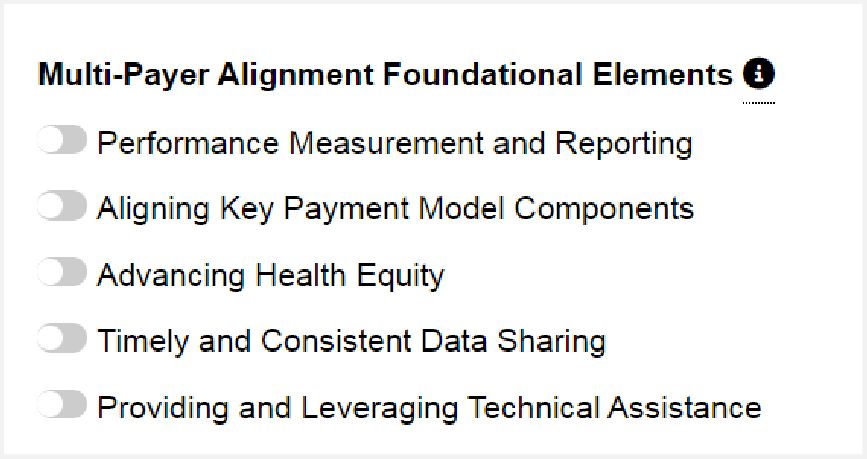August 17, 2015
Co-presenters answer participants’ questions on Bundled Payments for Care Improvement and Comprehensive Care for Joint Replacement that were not answered during the webinar.
That chart reflects the participants in Model 2 that are directly participating in the model — either as Awardees or as Episode Initiators. Although SNFs may furnish services to beneficiaries during a Model 2 episode, SNFs cannot participate as Awardees or as Episode Initiators in Model 2. SNFs are eligible to participate as Awardees or as Episode Initiators in Model 3.
We have not prepared this data for BPCI. However, on the BPCI website we list all of the participants in Models 1- 4 of BPCI.
In section III.D of the Comprehensive Care for Joint Replacement model proposed rule we discuss our proposals to tie quality measures to reconciliation payments.
We have proposed Medicare beneficiaries that initiate an episode in the Comprehensive Care for Joint Replacement model will retain their full rights to choose their providers. In order to decrease episode spending, hospitals included in this model will be incentivized to refer beneficiaries to highquality, low-cost providers. This proposed rule does not alter the existing responsibilities that hospitals have to share post-acute care provider information with beneficiaries when considering a post-acute care provider.
We have proposed that chronic conditions, such as diabetes, would be included in the calculation of episode spending, because these conditions may be affected by the care furnished during the episode.
In order for a beneficiary to be included in an episode initiated in Comprehensive Care for Joint Replacement model, we have proposed that Medicare must be the primary payer. Where Medicare is the primary payer, and the beneficiary fulfills the other criteria for inclusion in the model described in section III.B.2.a of the Comprehensive Care for Joint Replacement model proposed rule, then the episode spending would include Medicare spending for all Part A and Part B services furnished to the beneficiary, except for the services that are specifically excluded in the rule.
We propose, in section III.B.2 of the proposed rule to exclude unrelated inpatient hospital admissions during the episode by identifying MS–DRGs for exclusion. We propose to exclude unrelated Part B services based on the ICD–9–CM diagnosis code (or their ICD–10–CM equivalents when ICD–10–CM codes are implemented) that is the principal diagnosis code reported on claims for services furnished during the episode. More specifically, we propose to exclude specific inpatient hospital admissions and services consistent with the lower extremity joint replacement (LEJR) episode definition (also triggered by MS–DRGs 469 and 470) that is currently used in BPCI Model 2.
Please see section III.C.10 of the proposed rule, which includes a detailed discussion of internal cost savings (ICS), including a requirement that ICS “must be transparent, measurable, and verifiable in accordance with Generally Accepted Accounting Principles (GAAP) and Government Auditing Standards (The Yellow Book),” as well as a requirement that the methodology included in any agreement between a participant hospital and another party must set out the specific care redesign elements to be undertaken by the participant hospital or the collaborator or both with regard to ICS.
Please see section III.C.10 of the proposed rule, in which we detail the types of financial arrangements that participant hospitals may consider with other provider and supplier types.
Yes. We have proposed that beneficiaries that are aligned with an ACO could also be included in an episode in the Comprehensive Care for Joint Replacement model.
All Medicare beneficiaries that meet the criteria for inclusion in an episode, set forth in section III.B.2, will be included in the model.
We have proposed to use a total knee arthroplasty and/ or total hip arthroplasty (TKA/THA) patient-reported outcome measure that has been under development at CMS, as described in sections III.C.5(b)(2) and III.D.3 of the proposed rule.
Please see sections III.C.5(b)(2) and III.D.3 of the proposed rule, in which we discuss the use of a voluntary TKA/THA patient-reported outcome measure. We have proposed that a hospital that successfully meets the reporting threshold for this measure would have its discount reduced from 2 to 1.7.
Please see section III.C.10 of the proposed rule, in which we detail the types of financial arrangements that hospitals and certain providers (including physicians and physician group practices) might enter into in order to encourage financial alignment between various provider/ supplier types. For example, we have proposed that a hospital could share internal cost savings with certain provider/supplier types. Where a hospital experiences decreases in internal cost savings by instituting care redesign strategies or changes to the hospital’s processes (such as standardizing implant choices, for example), the hospital might choose to share those savings with providers/ suppliers that furnish services to beneficiaries during a Comprehensive Care for Joint Replacement episode, in order to incentivize compliance from those providers/ suppliers.


















 Emily DuHamel Brower, M.B.A., is senior vice president of clinical integration and physician services for Trinity Health. Emphasizing clinical integration and payment model transformation, Ms. Brower provides strategic direction related to the evolving accountable healthcare environment with strong results. Her team is currently accountable for $10.4B of medical expense for 1.6M lives in Medicare Accountable Care Organizations (ACOs), Medicare Advantage, and Medicaid and Commercial Alternative Payment Models.
Emily DuHamel Brower, M.B.A., is senior vice president of clinical integration and physician services for Trinity Health. Emphasizing clinical integration and payment model transformation, Ms. Brower provides strategic direction related to the evolving accountable healthcare environment with strong results. Her team is currently accountable for $10.4B of medical expense for 1.6M lives in Medicare Accountable Care Organizations (ACOs), Medicare Advantage, and Medicaid and Commercial Alternative Payment Models. Mr. James Sinkoff is the Deputy Executive Officer and Chief Financial Officer for Sun River Health (formerly known as Hudson River HealthCare), and the Chief Executive Officer of Solutions 4 Community Health (S4CH); an MSO serving FQHCs and private physician practices.
Mr. James Sinkoff is the Deputy Executive Officer and Chief Financial Officer for Sun River Health (formerly known as Hudson River HealthCare), and the Chief Executive Officer of Solutions 4 Community Health (S4CH); an MSO serving FQHCs and private physician practices. Victor is the Chief Medical Officer for TennCare, Tennessee’s Medicaid Agency. At TennCare, Victor leads the medical office to ensure quality and effective delivery of medical, pharmacy, and dental services to its members. He also leads TennCare’s opioid epidemic strategy, social determinants of health, and practice transformation initiatives across the agency. Prior to joining TennCare, Victor worked at Evolent Health supporting value-based population health care delivery. In 2013, Victor served as a White House Fellow to the Secretary of Health and Human Services. Victor completed his Internal Medicine Residency at Emory University still practices clinically as an internist in the Veteran’s Affairs Health System.
Victor is the Chief Medical Officer for TennCare, Tennessee’s Medicaid Agency. At TennCare, Victor leads the medical office to ensure quality and effective delivery of medical, pharmacy, and dental services to its members. He also leads TennCare’s opioid epidemic strategy, social determinants of health, and practice transformation initiatives across the agency. Prior to joining TennCare, Victor worked at Evolent Health supporting value-based population health care delivery. In 2013, Victor served as a White House Fellow to the Secretary of Health and Human Services. Victor completed his Internal Medicine Residency at Emory University still practices clinically as an internist in the Veteran’s Affairs Health System. Dr. Brandon G. Wilson, DrPH, MHA (he, him, his) joined Community Catalyst as the Director of the Center for Consumer Engagement in Health Innovation, where he leads the Center in bringing the community’s experience to the forefront of health systems transformation and health reform efforts, in order to deliver better care, better value and better health for every community, particularly vulnerable and historically underserved populations. The Center works directly with community advocates around the country to increase the skills and power they have to establish an effective voice at all levels of the health care system. The Center collaborates with innovative health plans, hospitals and providers to incorporate communities and their lived experience into the design of systems of care. The Center also works with state and federal policymakers to spur change that makes the health system more responsive to communities. And it provides consulting services to health plans, provider groups and other health care organizations to help them create meaningful structures for engagement with their communities.
Dr. Brandon G. Wilson, DrPH, MHA (he, him, his) joined Community Catalyst as the Director of the Center for Consumer Engagement in Health Innovation, where he leads the Center in bringing the community’s experience to the forefront of health systems transformation and health reform efforts, in order to deliver better care, better value and better health for every community, particularly vulnerable and historically underserved populations. The Center works directly with community advocates around the country to increase the skills and power they have to establish an effective voice at all levels of the health care system. The Center collaborates with innovative health plans, hospitals and providers to incorporate communities and their lived experience into the design of systems of care. The Center also works with state and federal policymakers to spur change that makes the health system more responsive to communities. And it provides consulting services to health plans, provider groups and other health care organizations to help them create meaningful structures for engagement with their communities. Tamara Ward is the SVP of Insurance Business Operations at Oscar Health, where she leads the National Network Contracting Strategy and Market Expansion & Readiness. Prior to Oscar she served as VP of Managed Care & Network Operations at TriHealth in Southwest Ohio. With over 15 years of progressive health care experience, she has been instrumental driving collaborative payer provider strategies, improving insurance operations, and building high value networks through her various roles with UHC and other large provider health systems. Her breadth and depth of experience and interest-based approach has allowed her to have success solving some of the most complex issues our industry faces today. Tam is passionate about driving change for marginalized communities, developing Oscar’s Culturally Competent Care Program- reducing healthcare disparities and improving access for the underserved population. Tamara holds a B.A. from the University of Cincinnati’s and M.B.A from Miami University.
Tamara Ward is the SVP of Insurance Business Operations at Oscar Health, where she leads the National Network Contracting Strategy and Market Expansion & Readiness. Prior to Oscar she served as VP of Managed Care & Network Operations at TriHealth in Southwest Ohio. With over 15 years of progressive health care experience, she has been instrumental driving collaborative payer provider strategies, improving insurance operations, and building high value networks through her various roles with UHC and other large provider health systems. Her breadth and depth of experience and interest-based approach has allowed her to have success solving some of the most complex issues our industry faces today. Tam is passionate about driving change for marginalized communities, developing Oscar’s Culturally Competent Care Program- reducing healthcare disparities and improving access for the underserved population. Tamara holds a B.A. from the University of Cincinnati’s and M.B.A from Miami University.


 Dr. Peter Walsh joined the Colorado Department of Health Care Policy and Financing as the Chief Medical Officer on December 1, 2020. Prior to joining HCPF, Dr. Walsh served as a Hospital Field Representative/Surveyor at the Joint Commission, headquartered in Oakbrook Terrace, Illinois.
Dr. Peter Walsh joined the Colorado Department of Health Care Policy and Financing as the Chief Medical Officer on December 1, 2020. Prior to joining HCPF, Dr. Walsh served as a Hospital Field Representative/Surveyor at the Joint Commission, headquartered in Oakbrook Terrace, Illinois.








